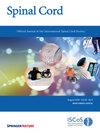神经转移至前骨间神经修复脊髓和臂丛损伤手指屈曲:系统回顾和个体患者数据荟萃分析。
IF 2.2
4区 医学
Q3 CLINICAL NEUROLOGY
引用次数: 0
摘要
研究设计:系统评价和荟萃分析。目的:颈脊髓损伤(SCI)和臂丛损伤(BPI)可导致手部瘫痪。手部运动的重建与功能和生活质量的改善有关。我们综合了各种神经转移到前骨间神经(AIN)后手指和拇指屈曲的结果。方法:根据PRISMA指南进行系统的文献综述和meta分析。成功的手指和拇指屈曲恢复定义为医学研究委员会(MRC)分级≥3。结果:共进行了23项研究,99例患者,120例神经转移到AIN。从受伤到手术的平均时间间隔为12.8个月,平均随访时间为24个月。总体而言,81/120(67.5%)和68/102(66.7%)只手分别成功恢复手指和拇指屈曲。94例神经移植的个体患者数据可用。损伤类型(SCI vs BPI/外周)不影响手指屈曲结果(OR 1.92, 95%CI 0.74-5.0, p = 0.17)。在调整损伤机制、手术损伤时间和随访时间的多因素分析中,使用肱桡肌(BR)分支(25%,1/4,OR 0.01, 95% ci 0.0006-0.44, p = 0.01)和肱桡肌(BA)分支(59%,30/51,OR 0.06, 95% ci 0.006-0.68, p = 0.02)作为供体,与使用桡侧短腕伸肌(ECRB)(95%, 19/20)相比,成功恢复手指屈曲的几率具有统计学意义显著性低。结论:脊髓损伤和BPI/外周型损伤的结果相似。ECRB作为供体在成功恢复手指屈曲方面优于BA或BR分支。本文章由计算机程序翻译,如有差异,请以英文原文为准。

Nerve transfers to anterior interosseous nerve for restoration of finger flexion in spinal cord and brachial plexus injury: a systematic Review and individual-patient-data meta-analysis
Systematic review and meta-analysis. Cervical spinal cord injury (SCI) and brachial plexus injury (BPI) can result in hand paralysis. Reconstruction of hand motion is associated with improved functionality and quality of life. We synthesized the outcomes of finger and thumb flexion after various nerve transfers to the anterior interosseous nerve (AIN). A systematic literature review and meta-analysis was performed according to the PRISMA guidelines. Successful finger and thumb flexion recovery was defined as Medical research council (MRC) grade ≥3. In total, 23 studies with 99 patients and 120 nerve transfers to the AIN were performed. The mean interval from injury to surgery was 12.8 months and mean follow-up duration was 24 months. Overall, 81/120 (67.5%) and 68/102 (66.7%) hands achieved successful finger and thumb flexion recovery, respectively. Individual-patient-data were available for 94 nerve transfers. Type of injury (SCI vs BPI/peripheral) did not affect finger flexion outcomes (OR 1.92, 95%CI 0.74–5.0, p = 0.17). On multivariate analysis adjusted for mechanism of injury, timing of injury to surgery and duration of follow-up, utilization of the brachioradialis (BR) branch (25%, 1/4, OR 0.01, 95%CI 0.0006–0.44, p = 0.01) and brachialis (BA) branch (59%, 30/51, OR 0.06, 95%CI 0.006–0.68, p = 0.02) as donors, were associated with statistically significant lower odds of successful finger flexion recovery compared to extensor carpi radialis brevis (ECRB) use (95%, 19/20). Similar outcomes were observed with SCI and BPI/peripheral type injuries. ECRB utilization as a donor was superior to BA or BR branch in terms of successful finger flexion recovery.
求助全文
通过发布文献求助,成功后即可免费获取论文全文。
去求助
来源期刊

Spinal cord
医学-临床神经学
CiteScore
4.50
自引率
9.10%
发文量
142
审稿时长
2 months
期刊介绍:
Spinal Cord is a specialised, international journal that has been publishing spinal cord related manuscripts since 1963. It appears monthly, online and in print, and accepts contributions on spinal cord anatomy, physiology, management of injury and disease, and the quality of life and life circumstances of people with a spinal cord injury. Spinal Cord is multi-disciplinary and publishes contributions across the entire spectrum of research ranging from basic science to applied clinical research. It focuses on high quality original research, systematic reviews and narrative reviews.
Spinal Cord''s sister journal Spinal Cord Series and Cases: Clinical Management in Spinal Cord Disorders publishes high quality case reports, small case series, pilot and retrospective studies perspectives, Pulse survey articles, Point-couterpoint articles, correspondences and book reviews. It specialises in material that addresses all aspects of life for persons with spinal cord injuries or disorders. For more information, please see the aims and scope of Spinal Cord Series and Cases.
 求助内容:
求助内容: 应助结果提醒方式:
应助结果提醒方式:


